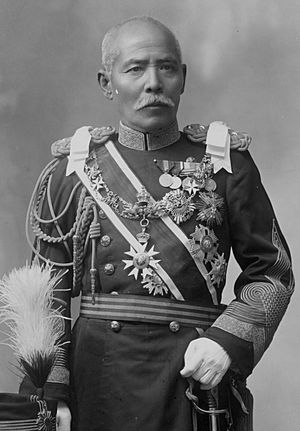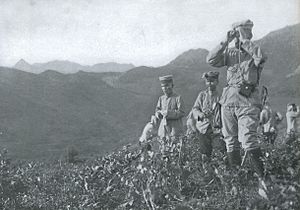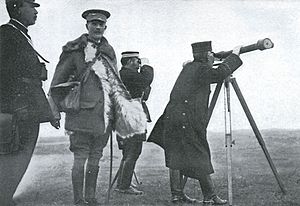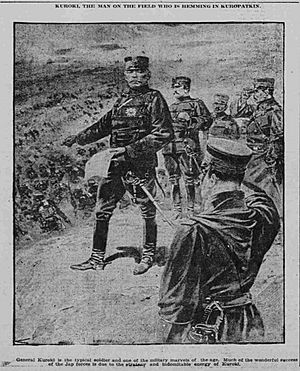Kuroki Tamemoto facts for kids
Quick facts for kids
Count
Kuroki Tamemoto
|
|
|---|---|

General Count Kuroki Tamemoto
|
|
| Born | 3 May 1844 Satsuma Domain (now Kagoshima Prefecture, Japan) |
| Died | 3 February 1923 (aged 78) Tokyo, Japan |
| Allegiance | |
| Service/ |
|
| Years of service | 1864–1869 1871–1909 |
| Rank | |
| Commands held | IJA 6th Division IJA 1st Army |
| Battles/wars | Boshin War First Sino-Japanese War Russo-Japanese War |
Count Kuroki Tamemoto (born May 3, 1844 – died February 3, 1923) was an important Japanese general in the Imperial Japanese Army. He led the Japanese First Army during the Russo-Japanese War. His forces won many battles in Manchuria, like the Battle of Yalu River, the Battle of Liaoyang, the Battle of Shaho, and the Battle of Mukden.
Contents
Early Life and Military Beginnings
Kuroki Tamemoto was born in 1844 in the Satsuma area of southern Kyūshū, which is now Kagoshima Prefecture. His father was a samurai, a warrior who served a powerful lord.
When he was young, Kuroki fought for the Shimazu clan. This was against the Tokugawa shogunate forces during the Boshin War. This war was part of the Meiji Restoration, a time when Japan changed its government.
Kuroki led a small group of soldiers in battles like the Battle of Toba–Fushimi and the Battle of Utsunomiya Castle. In February 1869, he became a lieutenant, which is a junior officer rank.
Rising Through the Ranks
In July 1871, Kuroki became a captain in the new Imperial Japanese Army. He quickly moved up in rank. In August 1872, he was made a major.
By February 1875, at only 31 years old, he was put in charge of the 12th Hiroshima Infantry Regiment. He was also promoted to lieutenant-colonel.
During the Satsuma Rebellion in 1877, Kuroki had to lead his regiment against his own home clan. He became a colonel in November 1878 and was put in charge of the 2nd Grenadiers. He was promoted to major-general in May 1885 and to lieutenant-general in November 1893.
He led the IJA 6th Division in the First Sino-Japanese War (1894-1895). During this war, he took part in the Battle of Weihaiwei.
Leading in the Russo-Japanese War
In November 1903, Kuroki was promoted to the rank of general. When the Russo-Japanese War began the next year, he was chosen to lead the Japanese First Army.
In mid-February, Kuroki landed his troops near Seoul. He then moved north and defeated a smaller Russian force at the Battle of the Yalu River in April-May 1904.
He commanded the left side of the Japanese army at the Battle of Liaoyang. Here, he successfully stopped a Russian attack from August 25 to September 3.
During the Battle of Shaho, Kuroki's forces again successfully defended against a Russian attack in October. Later, he led the Japanese right side at the Battle of Mukden from February 21 to March 10, 1905.
During the war, many Western observers and reporters were with Kuroki's army. News about the war was carefully controlled. This meant reporters had limits on where they could go and what they could report. This way of managing news became important in future wars.
A British general named Sir Ian Hamilton learned a lot from being with Kuroki's army. He later used these lessons in the 1915 Gallipoli Campaign. An American officer, Captain John J. Pershing, also learned from Kuroki's methods. He later used similar ideas for managing the press in World War I.
Later Life and Achievements
Even with all his success, Kuroki was not promoted to Field Marshal. Some people think this was because he was from Satsuma. At that time, the government was mostly led by rivals from the Chōshū area.
Kuroki retired from the military in 1909. He was given the title of danshaku (baron) and later hakushaku (count) under the kazoku system, which was a system of noble ranks.
From 1917 until his death in 1923, he served as the Lord Keeper of the Privy Seal of Japan (内大臣, Naidaijin). This was a very important role, advising the Emperor. He died from pneumonia in 1923.
Honors and Recognition
Kuroki Tamemoto received many awards and honors for his service:
- Grand Cordon of the Order of the Rising Sun (May 30, 1905)
- Hon. Knight Grand Cross of the Order of St. Michael and St. George (GCMG) (February 20, 1906)
- Baron (April 1, 1906)
- Order of the Golden Kite, 1st Class (April 1, 1906)
- Grand Cordon of the Order of the Rising Sun with Paulownia Flowers (April 1, 1906)
- Commander Grand Cross of the Order of the Sword (1906)
- Order of the Plum Blossom (December 28, 1906)
- Count (1909)
Two towns in North America were named after him: Kuroki, Saskatchewan in Canada and Kuroki, North Dakota in the United States.
See also
 In Spanish: Kuroki Tamemoto para niños
In Spanish: Kuroki Tamemoto para niños





